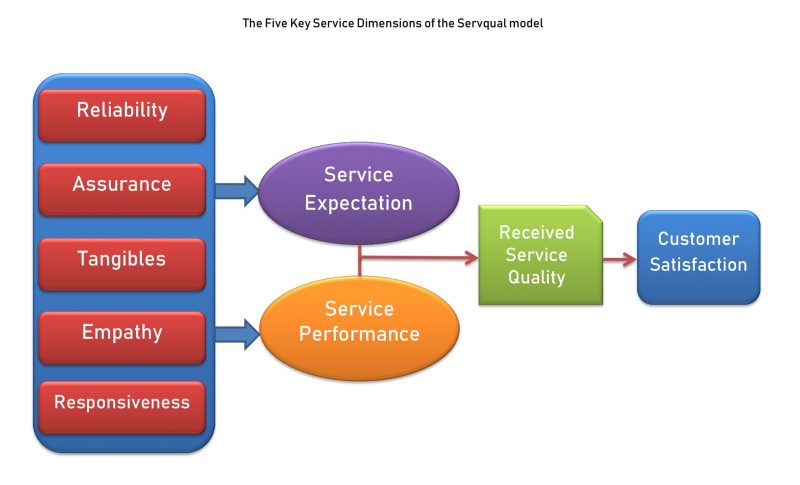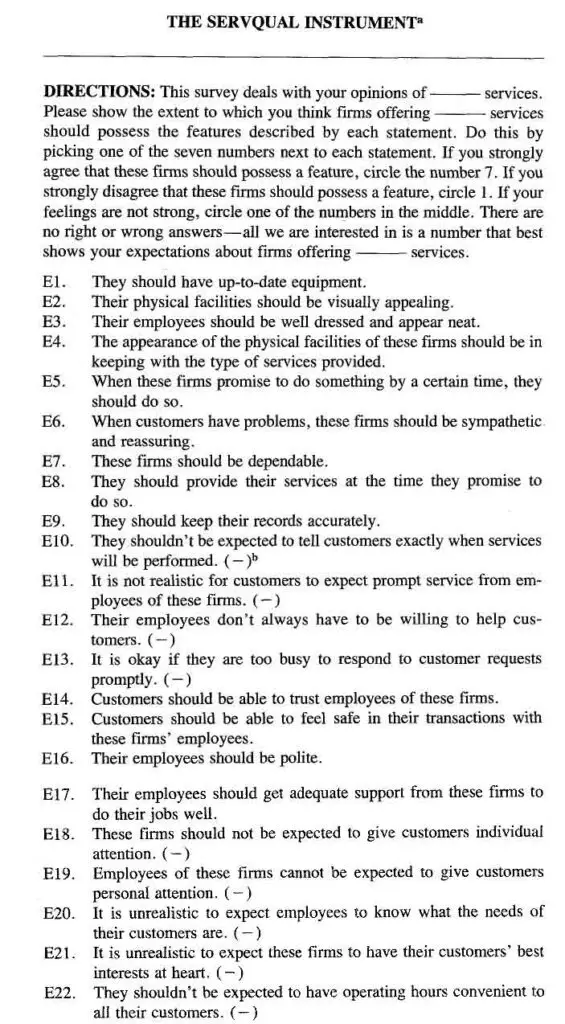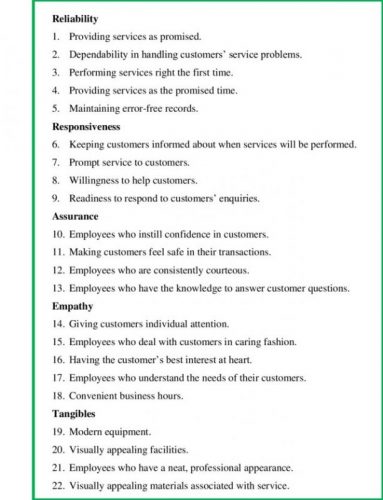The article explains the 5 Dimensions of Service Quality (SERVQUAL) Model. It also shows the SERVQUAL Model of Service Quality Questionnaire Instruments for customer satisfaction.
Five Dimensions of Service Quality
In 1985, three American marketing scholars —A. Parasuraman, Valarie A. Zeithaml, and Leonard L. Berry established 10 service quality dimensions based on customer evaluations. Customers evaluate the services they receive from organizations. Initially, the authors proposed 10 dimensions to assess service quality. Later, the authors condensed ten dimensions into five and introduced a refined SERVQUAL Model in 1988.
The ten dimensions include Reliability, Tangibles, Responsiveness, Competence, Access, Courtesy, Communication, Credibility, Security, and Understanding.
The five dimensions of service quality are the SERVQUAL Model’s five key service dimensions: Reliability, Assurance, Tangibles, Empathy, and Responsiveness. The Servqual model, or five service quality dimensions, is also known as the Service Quality Model. SERVQUAL is the short form of service quality. The SERVQUAL Model is a multi-dimensional research framework intended to measure the gap between expected and perceived service quality for customers across five dimensions.
Therefore, the five-service quality dimension model was introduced in 1988 by A. Parasuraman, Valarie A. Zeithaml, and Leonard L. Berry. The researchers and practitioners use the latest SERVQUAL model.
SERVQUAL Model
The SERVQUAL model refers to the five dimensions of service quality that measure customer expectations. The SERVQUAL model classifies the elements or components of service quality into five critical service quality dimensions. Although the model developers initially proposed 10 service quality dimensions, many experts later finalized only 5: Reliability, Assurance, Tangibles, Empathy, and Responsiveness. The marketing students formed the acronym RATER from the first letters of each dimension or component. However, after measuring the gaps, this model recommends the most common causes of service quality problems.
Servqual Model 10 Dimensions
However, initially, the authors of the SERVQUAL model presented ten dimensions of service quality as follows: Reliability, Responsiveness, Competence, Access, Courtesy, Communication, Credibility, Security, Knowing the Customer, and Tangibles.

Dimensions of Service Quality
The 5 Dimensions of Service Quality are
- Reliability
- Assurance
- Tangibles
- Empathy
- Responsiveness.
1. Reliability in the Servqual Model
Reliability is an essential dimension of the Servqual model that confirms the capacity to provide services exactly, on time, and credibly. It means a service provider’s ability to deliver services consistently and accurately, meeting customers’ expectations every time. Consistency is critical for providing assistance or products to customers on time, with no errors. You have to respect your commitment to provide your service on time and accurately, as you promised to them.
For example, Hotel Global Assistant prides itself on reliable and consistent service to its guests. One aspect of reliability is the hotel’s commitment to ensuring that rooms are ready for check-in at the designated time, without any delays or errors.
Guests arriving at Hotel Global Assistant expect to be able to check into their rooms promptly upon arrival, based on their reservation. The hotel’s front desk staff ensures that rooms are prepared well in advance, following a standardized process for cleaning, maintenance, and inspection.
Upon arrival, guests are warmly greeted by the front desk staff, who efficiently handle check-in. The staff verifies guests’ reservations, assigns rooms based on their preferences, and promptly provides them with keys.
Throughout their stay, guests experience consistent and reliable service from the hotel staff. Housekeeping maintains the cleanliness and orderliness of the rooms, ensuring that amenities are replenished and any issues are promptly addressed. The hotel’s facilities, such as restaurants, fitness centers, and business centers, operate smoothly and reliably, meeting guests’ needs and expectations.
2. Assurance in the Servqual Model
Assurance means building trust and credibility with customers. It depends on the employee’s technical knowledge, practical communication skills, courtesy, credibility, competency, and professionalism. Therefore, these skills will help the organization gain customer trust and credibility.
The assurance dimension combines four factors: Competence, Courtesy, Credibility, and Security. Firstly, competence means having the requisite skills and knowledge. Secondly, courtesy refers to the politeness, respect, consideration, and friendliness of contact staff. Thirdly, credibility is the staff’s trustworthiness, believability, and honesty. Finally, security means freedom from danger, risk, or doubt.
Example of Assurance Dimension in SERVQUAL Model
The employee demonstrates competence, courtesy, credibility, and professionalism when serving customers.
Assurance Example in Retail Banking Services
In the context of retail banking services, the Assurance dimension of the SERVQUAL model plays a crucial role in building customer trust and confidence. Let’s consider a scenario where a customer visits a bank branch to inquire about opening a new savings account:
Competence
The customer approaches a bank representative and expresses interest in opening a savings account. The representative demonstrates competence by thoroughly explaining the different types of accounts available, their features, and the associated benefits. They are knowledgeable about the bank’s products and services, providing accurate information to help customers make informed decisions.
Courtesy
The bank representative maintains a courteous and respectful demeanor throughout the interaction. They greet the customer warmly, listen attentively to their needs and preferences, and address any questions or concerns with patience and empathy. The customer feels valued and respected, contributing to a positive service experience.
Credibility
The bank has established a reputation for reliability and integrity in the community. The representative reinforces this credibility by providing transparent information about account fees, interest rates, and terms and conditions. They assure the customer that the bank is committed to upholding ethical standards and safeguarding their financial interests, thereby earning their trust and confidence.
Security
As the customer considers opening a new account, they express concerns about the security of their funds and personal information. The bank representative assures the customer that the bank employs robust security measures to protect against fraud, identity theft, and unauthorized access to accounts. They explain the various security features, such as encryption protocols, multi-factor authentication, and fraud monitoring systems, to reassure the customer of the bank’s commitment to safeguarding their assets and privacy.
In this example, the Assurance dimension of the SERVQUAL model is exemplified through the bank’s focus on competence, courtesy, credibility, and security in delivering retail banking services
3. Tangibles in the Servqual Model
Tangibles represent the physical facilities, employees’ appearance, equipment, machines, communication materials, and information systems. It focuses on facilitating materials and physical facilities.
This dimension assesses the extent to which these tangible elements convey professionalism, competence, and attention to detail, influencing customers’ perceptions of service quality. For example, the organization maintains a clean environment, and staff follow the appropriate dress code.
The example of Tangibles in the SERVQUAL model
1. Physical Facilities: Physical facilities refer to the organization’s environment where the service is delivered. It includes the company’s infrastructure, such as buildings, furniture, decorations, location, and amenities. For example, a meeting room, reception area, office location, and well-decorated space enhance the tangible aspects of the service.
2. Equipment and Tools: Tangibles also encompass the use of equipment and tools by the organization to deliver the service. It includes computers, PoS (Point of Sale) machines, ICT, and other resources necessary for ensuring better service. For instance, in a Bank, Electronic Payment Systems, cash Deposit Machines (CDMs), Fraud Detection, High-Speed Wi-Fi, and an ATM adjacent to the bank are tangible factors that impact customer perceptions.
3. Personnel Appearance: The personal appearance of tangibles in the SERVQUAL model indicates employees’ education, attire, hygiene, status, moral character, social position, and trustworthiness. It promotes corporate branding by enhancing tangible assets. For instance, a well-dressed waiter, the cleanliness of the attire, and the receptionist’s behavior influence customers’ perceptions of service quality.
4. Communication Materials: Communication materials are a crucial element of tangibles in the SERVQUAL model. It includes communication channels such as social media platforms, banners, brochures, websites, and other promotional materials. For example, a travel agency’s website should be user-friendly, accessible, and concise, with information on ticket and hotel costs and travel guidelines.
Accessibility and Convenience: Tangibles also include factors such as ease of access and convenience for clients. The factors are parking facilities, male- and female-separated washrooms, features for people with disabilities, and free Wi-Fi for guests. For example, a banking company that offers ample parking, separate toilets for females, and wheelchair ramps enhances the tangible aspects of the customer experience.
4. Empathy in the Servqual Model
Empathy is the service provider’s ability to understand and address customers’ needs and concerns in a caring, personalized manner. It means focusing on customers attentively to ensure caring, distinguished service. It is also a great process to satisfy customers psychologically and increase confidence, trust, and loyalty. The company might lose customers due to a lack of empathy among employees; therefore, they need to ensure compassion.
Additionally, empathy is a combination of the following factors:
- Access (physical and social) – (For example, approachable and ease of contact).
- Communication – (For instance, keeping customers informed in a language they understand and listening to them).
- Understanding the customer (for example, getting to know customers and their specific needs).
Example of Empathy in SERVQUAL Model
For example, a customer contacts a telecommunications company’s customer service department to report an issue with their internet connection. The customer explains that they are working from home and urgently need a stable internet connection to complete an important project. The customer service representative, demonstrating empathy, responds with understanding and concern for the customer’s situation.
Instead of simply acknowledging the issue and providing generic troubleshooting steps, the representative actively listens to the customer’s concerns and expresses empathy for the inconvenience caused by the internet outage. They reassure the customer that they understand the importance of reliable internet access, especially for remote work, and assure them that resolving the issue is a top priority.
The representative goes a step further by offering personalized assistance tailored to the customer’s needs. They provide detailed guidance on troubleshooting steps specific to the customer’s internet setup and offer to escalate the issue to technical support for further investigation. Additionally, they proactively follow up with the customer to ensure the problem is fully resolved and offer compensation for any inconvenience caused.
Through their empathetic response, the customer service representative demonstrates a genuine understanding of the customer’s situation, instilling trust and confidence in the company’s commitment to customer satisfaction.
5. Responsiveness in the Servqual Model
Responsiveness refers to the eagerness to assist customers with respect and provide quick service to satisfy them. This dimension focuses on two essential factors: willingness and promptness. So, you have to ensure the customer receives their service quickly and feels you are very interested in helping them. Responsiveness will be defined by the time customers wait for an answer or solution. In short, responsiveness solves the customer’s problem as soon as possible by providing the expected information or replacing the product. To ensure responsive service quality, the employee keeps no customer waiting and replaces the product quickly before the promised period ends.
Example of the Responsiveness Dimension
For example, a customer visits a busy restaurant during peak hours and places an order. Despite the high volume of orders, the restaurant staff remained responsive, promptly acknowledging the customer’s order and providing an estimated wait time.
As the customer waits for their meal, they notice that their drink is running low. Before they even have a chance to flag down a server, a member of the restaurant staff proactively approaches their table to refill their drink and inquire if there’s anything else they need.
Later, when the customer’s meal arrives later than expected, the restaurant manager personally visits their table to apologize for the delay and assure them that their order is being expedited. The manager offers a complimentary appetizer as a gesture of goodwill for the inconvenience caused by the delay.
In this example, the restaurant staff demonstrates responsiveness by promptly addressing the customers’ needs and concerns throughout their dining experience.
SERVQUAL Survey Questionnaire
The Servqual survey refers to the instruments of the Servqual model. The instrument consists of 22 perception items. The researchers utilize these instruments to evaluate consumers’ thoughts and expectations regarding the quality of service. Therefore, it is also known as a SERVQUAL questionnaire for customer satisfaction. The authors of the SERVQUAL model developed 22 perception items and 22 expectation items to form five dimensions of service quality. The Servqual model questionnaire assesses the company’s gap score, which ideally comes out.
SERVQUAL Model Original Questionnaire Instruments
The original questionnaire instruments were adapted from the paper “A Conceptual Model of Service Quality and Its Implications for Future Research,” published in the Journal of Marketing in 1985.

Servqual Questionnaire Example With 22 Items
Reliability
- Providing services as promised.
- Dependability in handling customers’ service problems.
- Performing services right the first time.
- Providing services as promised on time.
- Maintaining error-free records.
Responsiveness
- Keeping customers informed about when services will be performed.
- Prompt service to customers.
- Willingness to help customers.
- Readiness to respond to customers’ inquiries
Assurance
- Employees who instill confidence in customers.
- Making customers feel safe in their transactions.
- Consistently courteous employees.
- Employees who know how to answer customer questions.
Empathy
- Giving customers individual attention.
- Employees who deal with customers in a caring fashion.
- Having the customer’s best interest at heart.
- Employees who understand the needs of their customers.
- Convenient business hours.
Tangibles
- Modern equipment.
- Visually appealing facilities.
- Employees who have a neat, professional appearance.
- Visually appealing materials associated with service.
SERVQUAL Model Questionnaire Image

SERVQUAL Questionnaire Example For Customer Satisfaction
Reliability Dimension1. Gloant-Automobile fixes faults in cars as promised. Assurance Dimension6. The apprentices of Gloant-Automobile create confidence in customers. Tangibles Dimension10. Gloant-Automobile makes use of modern equipment in repairing cars Empathy Dimension14. The apprentices of Gloant-Automobile give customers individual attention. Responsiveness Dimension19. This company always informs customers when services will be performed. |
Conclusion
In conclusion, the SERVQUAL model has become widely accepted and popular worldwide for its ability to improve customer service quality. It is a multidimensional research system that represents a customer satisfaction framework to better serve customers. Many organizations use this model to achieve goals. The private organization follows the Servqual model to ensure quality services. The 5 Gaps in Service Quality are the Knowledge Gap, Policy Gap, Communication Gap, Delivery Gap, and Customer Gap.
Citation For This Article (APA 7th Edition)
| Kobiruzzaman, M. M. (2025). Five Dimensions of Service Quality- Servqual Model of Service Quality. Newsmoor https://newsmoor.com/servqual-model-five-key-service-dimensions-servqual-gaps-reasons/ |
